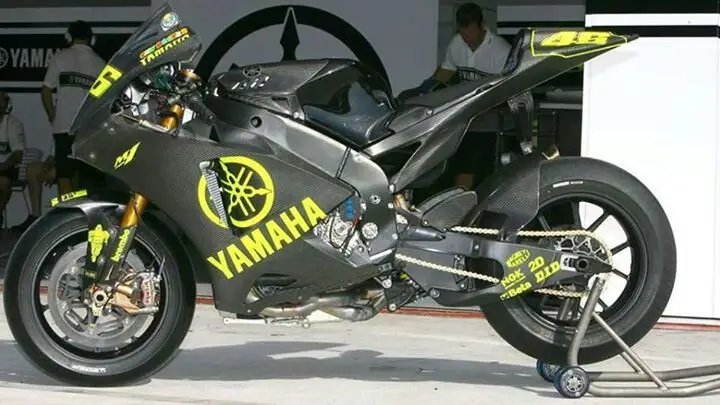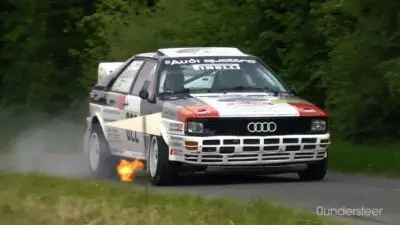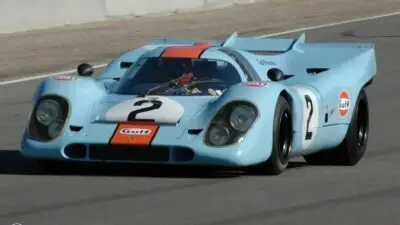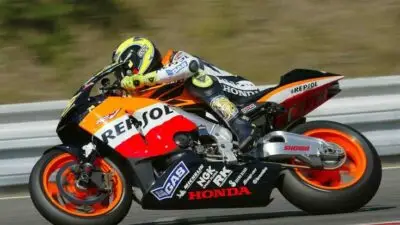The Yamaha YZR-M1 stands as one of the most successful motorcycles in MotoGP history. This inline-four racing machine was developed by Yamaha Motor Company to compete in the premier class of motorcycle racing. The bike replaced the 500cc YZR500 and started its MotoGP journey with a 990cc engine in 2002.

Valentino Rossi’s arrival at Yamaha in 2004 transformed both the rider’s career and the YZR-M1’s racing potential. The Italian legend tested multiple engine prototypes before selecting what he called a “sweet” engine. This partnership produced immediate results when Rossi won his debut race on the Yamaha in South Africa that same season.
The relationship between Rossi and the M1 became legendary in motorsport. He went on to win four MotoGP championships over nine seasons with the machine. The bike’s technical features, iconic races, and lasting impact on motorcycle racing created a story that goes far beyond simple wins and losses.
Key Takeaways
- The Yamaha YZR-M1 became a championship-winning machine after Valentino Rossi joined the team in 2004
- Rossi won four MotoGP titles with the YZR-M1 over nine seasons of racing together
- The partnership between Rossi and the M1 created one of the most famous stories in motorsport history
Overview of the Yamaha YZR-M1

The Yamaha YZR-M1 is an inline-four motorcycle specifically developed by Yamaha Motor Company to race in the current MotoGP series. This Japanese factory machine has evolved through multiple engine displacement changes and design updates since its MotoGP debut in 2002.
Development and Design Philosophy
Yamaha designed the YZR-M1 as a purpose-built MotoGP racing machine. The bike features key technical elements that define its character:
Engine Configuration:
- 1000cc liquid-cooled inline four-cylinder engine
- Over 250bhp power output
- Electronic fuel injection system
Chassis and Components:
The 2004 model adopted 4-valve combustion chamber and crossplane crankshaft technology. These changes improved connection and feedback for riders.
Evolution Since MotoGP Debut
The M1 has undergone major changes to meet different MotoGP regulations. Each era brought new challenges for the Japanese factory.
The 2004 model featured a 990cc YZR-M1 as Yamaha’s first MotoGP champion machine. This bike marked Yamaha’s entry into the four-stroke MotoGP era.
In 2007, the first 800cc model laid foundation for consecutive titles and maximized cornering speed. The smaller displacement required new engineering approaches.
The current 1000cc format returned in 2012. This brought back higher power levels and changed bike dynamics once again.
Yamaha Factory Team Role
The YZR-M1 serves as Yamaha’s official MotoGP entry through their factory racing program. The bike represents the company’s highest level of motorcycle technology.
The YZR-M1 was developed with Valentino Rossi, who won four championships with it. His input shaped the bike’s handling characteristics and overall design philosophy.
Other championship winners include:
The factory team uses rider feedback to develop new parts and settings. This process helps Yamaha improve both racing performance and future production bikes.
Valentino Rossi and the YZR-M1

Valentino Rossi’s partnership with Yamaha began in 2004 when he joined the team and immediately transformed the struggling YZR-M1 into a championship-winning machine. His collaboration with Yamaha engineers produced multiple world titles and established one of MotoGP’s most successful rider-manufacturer relationships.
Rossi’s Transition to Yamaha
Rossi’s arrival at Yamaha in 2004 marked a major turning point for the Japanese manufacturer. The YZR-M1 was struggling to compete and had serious handling problems that made it dangerous to ride.
Most people expected it would take a full year for Rossi to adapt to the new bike. Instead, Rossi fixed most of the M1’s problems in his first hours on the bike on January 24, 2004.
The bike had been so difficult to handle that the previous rider crashed 14 times during 2003. Rossi’s immediate feedback and riding style helped engineers understand what changes were needed.
Rossi tested multiple engine prototypes before selecting one he called a “sweet” engine. This choice became the foundation for the M1’s future success.
Key Milestones and Championships
Rossi won his first championship with Yamaha in 2004, just months after joining the team. This victory proved that both rider and machine had found the right combination.
2005 Season Dominance:
- Won the championship by 147 points over Honda’s Marco Melandri
- The 2005 M1 was considered a superior race bike that could beat competitors easily
- Demonstrated the strength of Rossi’s input in bike development
Rossi continued winning with Yamaha through multiple seasons. His last world title on the YZR-M1 came in 2009, marking the end of their most successful period together.
The partnership lasted until 2010 when Rossi moved to Ducati. He later returned to Yamaha from 2013 to 2021, though without the same championship success.
Collaboration with Yamaha Engineers
Rossi played a vital role in developing the YZR-M1 throughout his time with the team. His technical feedback helped engineers create multiple versions of the bike that matched his riding style.
Key Development Areas:
- Engine characteristics and power delivery
- Chassis balance and handling
- Electronics integration
- Suspension setup
The relationship between Rossi and the M1 became famous in motorsport circles. Engineers valued his precise feedback about how the bike felt and performed in different conditions.
Yamaha released technical documents each season detailing the M1’s continued development. This process continued through 2010, marking the end of an era when Rossi left the team.
The collaboration method established with Rossi became a template for how Yamaha worked with future riders. His influence on the M1’s development continued even after his departure from the team.
Technical Features of Rossi’s MotoGP Bike

The Yamaha YZR-M1 features a 1000cc liquid-cooled engine with advanced aerodynamics and cutting-edge electronics. Rossi worked closely with Yamaha engineers to develop these technical specifications throughout his career with the M1.
Engine and Powertrain Specifications
The YZR-M1 uses an inline four-cylinder engine configuration. The 2020 Monster Energy Yamaha MotoGP machines featured the same cross-plane crankshaft design that made over 240 horsepower.
The engine displacement measures exactly 1000cc with liquid cooling. This four-stroke design replaced the earlier two-stroke engines when MotoGP switched formats.
Rossi tested multiple engine prototypes in 2004 before selecting one he called a “sweet” engine. The cross-plane crankshaft became a signature feature of the M1.
The engine produces maximum power at around 13,000 RPM. Fuel injection systems deliver precise air-fuel mixtures for optimal performance across different track conditions.
Chassis and Aerodynamics
The Yamaha YZR-M1 features a streamlined body that reduces drag for better acceleration and cornering. The aluminum frame provides structural rigidity while maintaining flexibility for handling.
The fairing design focuses on airflow management. Engineers crafted the bodywork to reduce turbulence and improve stability at high speeds.
Key aerodynamic features include:
- Front fairing: Channels air around the rider
- Side panels: Direct airflow away from rear wheel
- Tail section: Minimizes drag coefficient
The suspension system uses adjustable components front and rear. Carbon fiber wheels reduce unsprung weight for improved handling response.
Electronics and Control Systems
The M1 incorporates advanced electronic systems for traction control and power delivery. These systems help riders manage the 240+ horsepower output safely.
Engine management computers adjust fuel mapping based on throttle position and lean angle. Anti-wheelie systems prevent the front wheel from lifting during acceleration.
Data acquisition systems record hundreds of parameters during practice and races. Engineers analyze this telemetry to optimize bike setup for each track.
The electronics package includes launch control for race starts. Riders can adjust settings through handlebar-mounted controls during races.
Influential Seasons and Iconic Races

Valentino Rossi’s partnership with the YZR-M1 produced championship-defining moments that shaped MotoGP history. His debut victory in South Africa launched a legendary career phase, while battles at Sepang became defining moments of his rivalry with teammate Jorge Lorenzo.
2004: Rossi’s First Season with Yamaha
Rossi’s move to Yamaha in 2004 shocked the MotoGP world. Many doubted his decision to leave the dominant Honda team for Yamaha’s struggling program.
The YZR-M1 underwent major development to match Rossi’s riding style. Yamaha’s engineers worked tirelessly to transform the bike into a championship contender.
Key Technical Changes:
- Longer engine mounting spars for improved rigidity
- Lowered center of gravity for better traction
- Four-valve per cylinder configuration
- Enhanced aerodynamics with inclined cylinders
Rossi won his debut race on the Yamaha in Welkom, South Africa that same season. This victory proved the bike’s potential immediately.
The Italian rider went on to capture the 2004 championship. This achievement marked the beginning of Yamaha’s most successful era in MotoGP history.
Highlights from Sepang and Malaysia
The Sepang International Circuit became a crucial venue for Rossi’s YZR-M1 success. Malaysia’s demanding track conditions tested both rider and machine capabilities.
Rossi consistently performed well at this challenging circuit. The hot, humid conditions and technical layout suited the M1’s characteristics perfectly.
Notable Sepang Performances:
- Multiple podium finishes throughout his Yamaha career
- Strategic battles in championship-deciding races
- Demonstrations of the M1’s superior handling in tropical conditions
The Malaysian Grand Prix often served as a late-season decider. Rossi’s ability to manage tire wear and maintain pace in extreme heat showcased the YZR-M1’s reliability.
These races highlighted the bike’s adaptability to different climates. The M1’s liquid cooling system and electronic fuel injection proved crucial in Malaysia’s demanding environment.
Historic Rivalry with Jorge Lorenzo
Jorge Lorenzo joined Yamaha as Rossi’s teammate in 2008. This partnership created one of MotoGP’s most intense internal rivalries.
Both riders competed on identical YZR-M1 machinery. Their different riding styles pushed Yamaha’s engineers to develop a more versatile machine.
Lorenzo won his first championship in 2010 with the M1. This victory came while Rossi was still his teammate, creating significant tension within the team.
Championship Results on the M1:
- Rossi: 4 titles (2004, 2005, 2008, 2009)
- Lorenzo: 3 titles (2010, 2012, 2015)
Their contrasting approaches benefited the bike’s development. Rossi’s aggressive style and Lorenzo’s smooth precision required different setup philosophies.
The rivalry reached its peak during the 2010 season. Lorenzo’s championship victory marked a changing of the guard in Yamaha’s hierarchy.
Yamaha YZR-M1 in the MotoGP Era

The Yamaha YZR-M1 replaced the YZR500 in 2002 when MotoGP switched to four-stroke engines. Yamaha faced tough competition from Honda and other manufacturers while building a strong legacy in the premier motorcycle racing series.
Competition with Other Manufacturers
Yamaha struggled badly in MotoGP’s early years. The Japanese factory won only two races in 2002 and 2003 combined. Honda dominated with 29 wins during the same period.
The 2003 season was particularly difficult for Yamaha. The M1 didn’t win a single race and scored only one podium. Alex Barros achieved that lone podium finish at Le Mans in wet conditions.
The bike had serious handling problems that made it dangerous to ride. Yamaha’s transition to four-stroke engines wasn’t smooth. The company needed major changes to compete with Honda’s superior RC211V.
Everything changed when Valentino Rossi joined Yamaha in 2004. His development skills helped transform the struggling M1 into a race-winning machine.
Yamaha’s Legacy in MotoGP
Yamaha has maintained its inline-four engine design throughout MotoGP. The company stuck with the across-the-frame layout while other manufacturers tried different approaches. This consistency helped Yamaha develop a deep understanding of their engine configuration.
The current M1 uses a 1000cc liquid-cooled inline four-cylinder engine. It features a cross-plane crankshaft design that provides smooth power delivery. This technical choice became a signature of Yamaha’s MotoGP bikes.
Yamaha’s partnership with top riders created lasting success. The Japanese factory won multiple championships with different riders. Their bikes became known for excellent handling and rider-friendly characteristics that allowed precise control at high speeds.
Yamaha releases detailed technical documents each season showing the M1’s development. This transparency demonstrates their commitment to continuous improvement in MotoGP competition.
Impact and Influence Beyond Racing

The YZR-M1’s racing success created lasting effects on Yamaha’s motorcycle business and brand image. Advanced technologies from Rossi’s championship-winning bike found their way into street motorcycles, while the partnership elevated Yamaha’s global reputation.
Technological Transfers to Production Bikes
The YZR-M1’s advanced engineering features have influenced Yamaha’s production motorcycles over the years. Fuel injection systems developed for the M1 helped improve throttle response and efficiency in street bikes.
Electronic rider aids pioneered on the YZR-M1 became standard features on high-end Yamaha motorcycles. Traction control and power delivery modes from MotoGP found their way into the YZF-R1 and other sport bikes.
The M1’s inline-four engine design influenced the development of Yamaha’s production sport bike engines. Engineers applied lessons learned from the race bike’s power delivery to create smoother, more responsive street engines.
Chassis development from the YZR-M1 program improved the handling characteristics of Yamaha’s production motorcycles. The aluminum frame technology and suspension tuning knowledge gained from racing helped create better-balanced street bikes.
Yamaha’s Global Brand and Future Developments
The YZR-M1’s success with Rossi transformed Yamaha into a premier motorcycle racing brand worldwide. The partnership brought nine world championships and established Yamaha as a serious competitor to Honda and Ducati.
Yamaha’s racing heritage from the M1 program continues to influence their marketing and product development. The bike’s legacy helps sell production motorcycles by connecting street riders to MotoGP success.
The YZR-M1’s championship-winning reputation attracts top riders and sponsors to Yamaha’s MotoGP program. This ongoing success maintains the brand’s competitive image in global markets.
Future Yamaha motorcycles will likely incorporate lessons learned from decades of M1 development. The race bike’s evolution continues to drive innovation in electronics, engine management, and aerodynamics for both racing and street applications.
Frequently Asked Questions

The Yamaha YZR-M1 features a 1000cc liquid-cooled inline-four engine that produces over 240 horsepower. Valentino Rossi played a crucial role in developing the bike after joining Yamaha in 2004.
What are the specifications of the Yamaha YZR-M1?
The Yamaha YZR-M1 features a 1000cc liquid-cooled engine designed specifically for MotoGP racing. The bike uses an inline-four configuration that replaced the previous 500cc two-stroke engines.
The M1 was originally developed with a 990cc engine when it debuted in 2002. The engine size was later changed to 1000cc to meet current MotoGP regulations.
The bike features advanced electronics and suspension systems built for professional racing. These components are constantly updated throughout each racing season.
How much horsepower does the Yamaha YZR-M1 produce?
Yamaha states the M1 produces “over 240 horsepower” but keeps the exact figure secret. The actual power output is likely higher than this official estimate.
Other MotoGP manufacturers produce similar power levels. KTM’s MotoGP bike already produces 270 horsepower according to available data.
The exact horsepower figures remain closely guarded secrets among all MotoGP teams. Teams rarely release precise power numbers to maintain competitive advantages.
What is the top speed of the Yamaha YZR-M1?
The YZR-M1 can reach speeds over 200 mph on long straightaways during MotoGP races. Top speeds vary depending on track layout and aerodynamic setup.
Different gear ratios are used for different circuits. Teams adjust the bike’s configuration based on each track’s characteristics.
The bike’s aerodynamics play a major role in top speed performance. Wind tunnels and computer simulations help optimize the bike’s shape for maximum speed.
Can you buy a Yamaha YZR-M1, and if so, where?
The Yamaha YZR-M1 is not available for public purchase. These bikes are built exclusively for MotoGP competition and remain property of the racing teams.
Each M1 costs hundreds of thousands of dollars to build. The bikes require constant maintenance from trained technicians.
Yamaha does not sell road-legal versions of the M1. The bike lacks the equipment needed for street use like lights and mirrors.
What engine does the Yamaha YZR-M1 use, and how many cc’s is it?
The YZR-M1 uses a 1000cc inline-four engine that is liquid-cooled for optimal performance. This four-cylinder design provides smooth power delivery across the rev range.
The engine was originally 990cc when the bike debuted in 2002. MotoGP regulations later standardized displacement at 1000cc for all manufacturers.
The inline-four configuration differs from other manufacturers who use V4 engines. Yamaha has continued with this design philosophy throughout the M1’s development.
How has Valentino Rossi’s involvement influenced the development of the Yamaha YZR-M1?
Valentino Rossi joined Yamaha in 2004 and immediately began developing the struggling M1. The bike had serious handling problems before his arrival.
Rossi fixed most of the M1’s problems during his first test session on January 24, 2004. He tested multiple engine prototypes before choosing one he called “sweet.”
Rossi won his debut race on the Yamaha at Welkom, South Africa in 2004. He went on to win four MotoGP championships during nine seasons with the M1.
The partnership between Rossi and Yamaha became one of motorsport’s most famous collaborations. His feedback helped transform the M1 from an uncompetitive bike into a championship winner.



